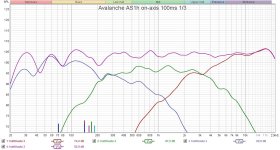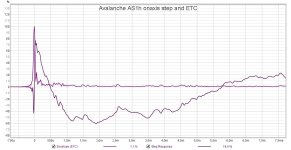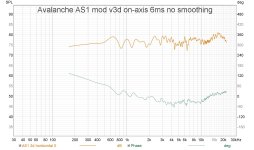I have wanted to like AMTs for a long time. I remember hearing an original Heil speaker and being a little let down by it. I have not heard very many AMT speakers since then, but none jumped out at me as really great... If we judged tweeters only by their CSD waterfall plot, AMTs would mostly drop out of consideration. Many people are enthusiastic about them, so obviously I have not been exposed to a good implementation yet...
j.
j.
In a 3-way IMO 19-26mm dome is best. 29mm and let alone all AMTs or planars have too high directivity
SBA 26mm with small plate https://sbacoustics.com/product/sb26stcn-c000-4/

https://sbacoustics.com/product/sb21sdcn-c000-4/

SBA 26mm with small plate https://sbacoustics.com/product/sb26stcn-c000-4/
https://sbacoustics.com/product/sb21sdcn-c000-4/
That one looks good. Wonder if the back can be removed for dipole operation?Try the new Dayton AMT: https://www.parts-express.com/Dayto...r-Motion-Transformer-4-Ohm-275-096?quantity=1
I REALLY like the Aurum Cantus AST2560, but I bought one recently and it looks like they made a change and isn't usable for me now. Which is too bad, we really need a good reasonably priced AMT. Most of them misbehave too much for my taste.
And what's different/worse about the current 2560? I bought 4 years ago. I like them lots -- without the thick facia. And run them as dipoles.
Except Scan speak can no longer make them as Materion has pulled the Be foil rug from them 😱D3004/6040 is my best choice, but I would like some additional choices.
https://www.aos-lautsprecher.de/news/
T25-B faceplate is 68mm and can be milled down if need be
In a 3-way IMO 19-26mm dome is best. 29mm and let alone all AMTs or planars have too high directivity
I like the 26STCN, I use it matched to SB15MFCs. But it's no AST2560. Not even close. Not as smooth, not as well behaved, and draws attention to itself (not always a bad thing), whereas the AST2560 disappears much better.
Except Scan speak can no longer make them as Materion has pulled the Be foil rug from them 😱
https://www.aos-lautsprecher.de/news/
T25-B faceplate is 68mm and can be milled down if need be
Who does Satori use for the supplier? That Textreme tweeter might be getting popular! I've heard the Ukraine war has Be becoming hard to get as Russia is the primary supplier.
There’s only one supplier for Beryllium foil used for cones and domes, and they have a monopoly on it.
And that’s Brush Wellman now Materion.
And that’s Brush Wellman now Materion.
In a 3-way IMO 19-26mm dome is best. 29mm and let alone all AMTs or planars have too high directivity
SBA 26mm with small plate https://sbacoustics.com/product/sb26stcn-c000-4/
View attachment 1214480
https://sbacoustics.com/product/sb21sdcn-c000-4/
View attachment 1214481
I used to think this too Juha. That small domes or ribbons are best in 3 or 4 ways. But then recently I’ve really enjoyed Ring Radiators and coaxials. And these guys have really not much output at wide angles, particularly in the top octave.
“More focused” sound; less “confused” sound.
So it might be related to rooms, acoustics and how they interact in the top octave. Or it might be a preference thing. I honestly don’t know…
Well, we shall see when I test both of them in a prototype cabinet.In a 3-way IMO 19-26mm dome is best. 29mm and let alone all AMTs or planars have too high directivity
Since this cabinet is 11.5" wide, and the maximum chamfer around the tweeter is 2", the baffle arround the tweeter will be 7.5" wide. A small faceplate has no advantage in this situation except that it might allow a smaller CTC spacing, which I will investigate tomorrow when I am at my other laptop.
One thing I have learned from doing a lot of VituixCad simulations... There seems to be limited application for 19mm or 20mm dome tweeters. The directivity is so wide up to almost 6k, and this makes it difficult to match up with a typical cone mid. Perhaps they might work well with a 50mm dome mid, but those kinds of mid drivers have limited applicability in themselves.
Now outside of simulation, I have heard many fine speakers that use a 19-20 mm dome tweeter. But I bet the Power and DI plot on those speakers was not ideal.
Thanks again to everyone for continuing to keep this thread interesting and informative.
Madisound still has them in stock for now... Hopefully ScanSpeak can sort this out...Except Scan speak can no longer make them as Materion has pulled the Be foil rug from them 😱
I have a vision for a future 4-way speaker... My existing SB34NRX woofer cabinets used as true subs, crossed at 100 Hz to a high performance 8-9" driver in it own cabinet, maybe Purifi, crossed at 500-800 to a Bliesma M74A, then on to a beryllium tweeter. The 74mm mid and tweeter would be in their own minimal-baffle oval-shaped enclosure, and a 75mm faceplate on the tweeter would be very helpful... It is a vision at this point... and totally off topic.
If you have difficulty sourcing Scan-Speak beryllium domes let me know Jim. We may be able to arrange a mutually beneficial arrangement.
Mwah-ha-ha! 😉 😏 😈
Mwah-ha-ha! 😉 😏 😈
Last edited:
One thing I have learned from doing a lot of VituixCad simulations... There seems to be limited application for 19mm or 20mm dome tweeters. The directivity is so wide up to almost 6k, and this makes it difficult to match up with a typical cone mid. Perhaps they might work well with a 50mm dome mid, but those kinds of mid drivers have limited applicability in themselves.
Now outside of simulation, I have heard many fine speakers that use a 19-20 mm dome tweeter. But I bet the Power and DI plot on those speakers was not ideal.
One good application of ~19mm tweeters is in combination with small 3-4" midranges, crossed over ~4kHz LR2. Midrange already beams at this Fc and above, while tweeter radiates wide. Using LR2 will blend both well and the resulting off axis responses and power response look good. I did this with 10F and R2004, and it sounded good. This approach is also good for 6+1 2way. Vertical responses are little bit worse compared to LR4, but we all know speaker building is about balancing the compromises.
Directivity alone is just one parameter! Excessive group delay caused by crossover is quite important in ear's sensitive range 1-5kHz. This can be heard in sound of eg. piano's right hand and violin's high notes, sort of easiness and naturality. LR2 or first order shine in this respect. And IMO this is one of the reasons some people love fullrange drivers and small 4-5" 2-ways made in old fashion.
My 3-way with 4" mid and 26mm tweeter, LR2 https://www.diyaudio.com/community/threads/avalanche-as1-modernization.321711/



My 3-way with 4" mid and 26mm tweeter, LR2 https://www.diyaudio.com/community/threads/avalanche-as1-modernization.321711/



Last edited:
Nope. I have a pair to test too...That one looks good. Wonder if the back can be removed for dipole operation?
Group delay in that region is already important to just get the crossover filter right.Excessive group delay caused by crossover is quite important in ear's sensitive range 1-5kHz.
That's very unfortunate! My old samples measure very well & match quite closely.Huge peak at 1.5khz then a steep drop off. I can't massage that.
Knowing you created custom waveguides for so many dome tweeters, I find it curious that you seem to rate the AST 2560 so highly. Among the dome tweeters you've tested and/or used, which do you think match or better the 2560? Sorry if this is off topic, btw.I like the 26STCN, I use it matched to SB15MFCs. But it's no AST2560. Not even close. Not as smooth, not as well behaved, and draws attention to itself (not always a bad thing), whereas the AST2560 disappears much better.
They already had one in a similar form factor and price, so I wonder what the difference is with this one.
Extended frequency range. The AMT2-4 has okay extension above 10Khz but can't go as low as the new AMTHR-4. The AMT3-4 doesn't extend quite as low and drops fast after 12Khz. AMTPRO extends low but drops off so much above 12khz that many people use a super-tweeter. The interesting thing to me is whether the AMTHR-4 cannibalizes the 2-4 and 3-4, as it seems to go both lower and higher.The new Dayton is interesting. They already had one in a similar form factor and price, so I wonder what the difference is with this one.
Here is a block diagram showing the signal processing concept of using a 2-channel DSP and 2-channel amp to make a 3-way speaker. Again I will reiterate that the whole reason this concept has merit is because 3-channel amplification options are limited, and the MiniDSP2x4 offers an entry level hardware DSP capability with 2-in 4-out. If there existed a MiniDSP 2x6 and a good $100 3-channel class-D amp, this approach would be less attractive...

---- ---- ----
I have been doing some simulations with various mid-tweeter CTC spacings, and in this situation, the CTC is not as critical as in some of my earlier speakers. The minimum CTC spacing that will geometrically fit is about 130mm, and the ideal driver simulation shows a pretty nice result. Variations in CTC spacing make some difference, but small changes in the acoustic offset between mid a tweeter make a difference also. So I am afraid I am running into the limits of simulation with ideal piston drivers. The small differences I am seeing are well within the simulation uncertainty.
I am not sure when I will get to constructing a foam board prototype. The next several months might be quite busy for me.
j.
---- ---- ----
I have been doing some simulations with various mid-tweeter CTC spacings, and in this situation, the CTC is not as critical as in some of my earlier speakers. The minimum CTC spacing that will geometrically fit is about 130mm, and the ideal driver simulation shows a pretty nice result. Variations in CTC spacing make some difference, but small changes in the acoustic offset between mid a tweeter make a difference also. So I am afraid I am running into the limits of simulation with ideal piston drivers. The small differences I am seeing are well within the simulation uncertainty.
I am not sure when I will get to constructing a foam board prototype. The next several months might be quite busy for me.
j.
- Home
- Loudspeakers
- Multi-Way
- Compact, low cost, active 3-way speaker